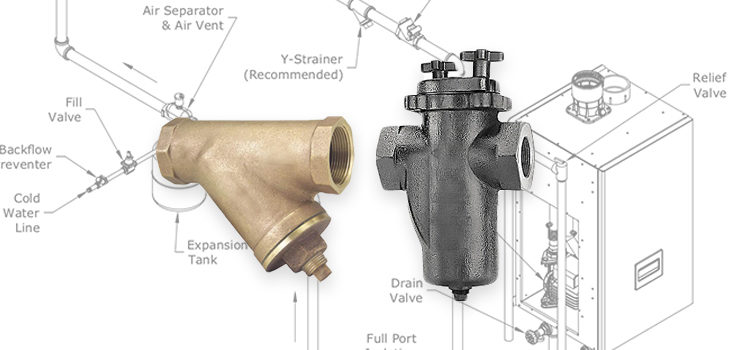By Rick Johnson, Applications Engineer for U.S. Boiler Company
I’ve never used a strainer before… why do I need one now? It’s a good question and one that most technicians have asked themselves at one time or another. Just because you haven’t used one in the past does not mean you did not need one.
Have you ever been draining a boiler and some of the water hit the floor? Of course! It’s happened to all of us. But, when you go to wipe it up, does the water leave a black stain? That’s boiler ink. Boiler ink has magnetite, which is a thin protective layer on the cast and piping. When this layer starts to get suspended in the water it needs to be removed. The pumps and the condensing heat exchangers with smaller passageways can be affected by this suspended ferrous material. This is why we need strainers!
Strainers by definition are a device which provide a means of mechanically removing solids from flowing fluid. This is accomplished by using perforated metal, mesh or wedge wire straining element.
Strainers are an investment – not an expense. They are employed to protect downstream mechanical equipment such as heat exchangers, pumps, meters and steam traps from the detrimental effects of sediment, rust, pipe scale or other extraneous debris.
Types of hydronic strainers
There are different types of strainers used in hydronic systems. The most commonly used is a Y-Strainer, but there is also the basket strainer. While we only use one type of Y-Strainer, there are many types of basket strainers. Vertical piping, frequently found at the pump inlets, necessitates the use of a Y- Strainer. Most basket strainers are intended for horizontal or slightly inclined piping. Special attention must be given to the orientation of the debris collection chamber and the drain or blowdown. It’s important to refer to manufacturer’s installation and operating manual. The strainer must be installed so that it is located at the lowest possible position. A Y-Strainer in vertical piping must be placed with its screen in the downward position to trap the sediment in the debris collection chamber.
Magnetic strainers are an effective solution to the problem of excessive and premature wear to pump seals and wear rings. A standard strainer is fitted with magnets which are removed for cleaning. These magnets are so spaced and arranged as to create a magnetic field around the interior of the screen and attract fine ferrous (magnetic) particle which could damage downstream equipment.
Installing and cleaning the strainer
Most pump installations designed for hydronic systems will permit approximately 2 PSI pressure drop across the strainer. When a screen becomes clogged, the pressure will increase. This increase varies with the clogging pattern experienced and the type of strainer being used. The type of debris being caught by the strainer and the type of strainer being used will determine the pressure drop. When installing the strainer be sure to isolate it with ball valves for servicing. When first installed, take a pressure reading from each side of the strainer, this is your baseline pressure drop for a clean strainer. If the pressure drop increases to between 5-10PSI then it’s time to clean the strainer.
Cleaning the strainer, whether it is a basket or Y-Strainer, is imperative. Performing periodic cleaning is essential in any strainer installation. Once you have determined the rate of clogging, a cleaning scheduled can be established. This part is crucial for condensing boilers. The most important part of the condensing boiler installation is the piping. Flow across the heat exchanger at a rate which will give us a good “Delta-T” is crucial. If you have a strainer which is starting to impede flow, it’s time to flush it.
Be aware of hidden strainers in premade headers. The system you’re working on may not look like it has a strainer, but if you have a header/hydronic separator you may have a strainer built in. Flushing may need to happen more often at the beginning but should be relegated to being purged at normal servicing times as the fluid is cleaned.
For questions or comments, please email training@usboiler.net

